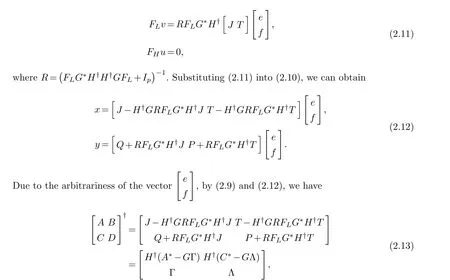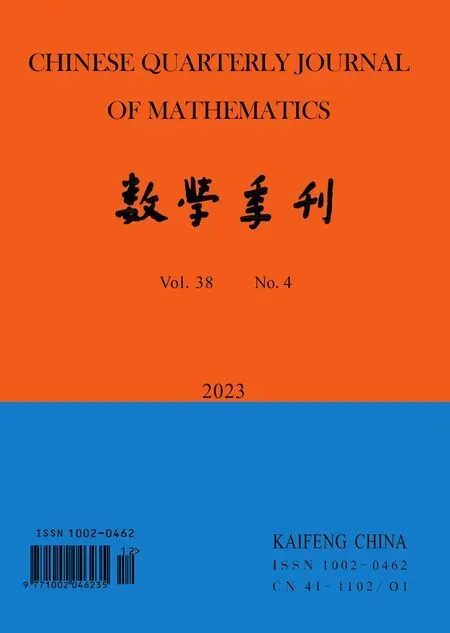The Explicit Formula for the Moore-Penrose Inverse of a 2×2 Block Matrix
,-
(School of Mathematics and Statistics, Hubei Normal University, Huangshi 435002, China)
Abstract: The representation for the Moore-Penrose inverse of the matrix
Keywords: Block matrix; Moore-Penrose inverse; Linear equation
§1.Introduction
Throughout this paper, Cm×ndenotes the set of allm×ncomplex matrices andIndenotes the identity matrix of sizen.ForA∈Cm×n, the Moore-Penrose inverse ofA, denoted byA†, is the unique solutionX ∈Cn×msatisfying the following four equations:
In 1991, Miao [6] established a formula of the Moore-Penrose inverse of a 2×2 block matrixMby using the{1,3}-inverse of the matrixMM∗.Baksalary and Trenkler [2] derived the formula for the Moore-Penrose inverse of a columnwise partitioned matrix.Yuan and Dai [8]provided the expression for the Moore-Penrose inverse of a columnwise partitioned matrix by using the theory of solving linear equations.Hung and Markham [5] deduced the formula of Moore-Penrose inverse of a 2×2 block matrix by using
Deng and Du [4] acquired the Moore-Penrose inverses of a 2×2 block operator valued matrices with specified properties on a Hilbert space.Yan [7] obtained an explicit expression of the Moore-Penrose inverse in terms of the partitioned matrix by using a full rank factorization of a 2×2 block matrix.In this paper, we will use the method presented in paper [8] to derive
Compared with the approach proposed in paper [5], the treatment in this paper is more concise and intuitive.
§2.Main results
To begin with, we introduce some lemmas.
Lemma 2.1.[3]If A∈Cm×q and b∈Cm.Then the equation Ay=b has a solution y ∈Cq if and only if AA†b=b,in which case,the general solution of the equation is y=A†b+FAz,where z ∈Cq is an arbitrary vector.
Lemma 2.2.[1]Let A∈Cm×n be partitioned as A=[A1,A2],then the following statements are equivalent:
(a)R(A1)∩R(A2)={0},
In the years to follow, the answers began to arrive, clear and satisfying beyond my most optimistic anticipation21. One of the answers was Enchanted22 Hills, where my nurse friend and I have the privilege of seeing blind children come alive in God’s out-of-doors. Others are the never-ending sources of pleasure and comfort I have found in friendship, in great music, and, most important of all, in my growing belief that as I attune23 my life to divine revelation, I draw closer to God and, through Him, to immortality24.
(b)R(A1∗)=R(A1∗EA2),
(c)R(A2∗)=R(A2∗EA1).
Lemma 2.3.[1]Let A∈Cm×n be partitioned as A=[A1,A2],then the following statements are equivalent:
(a)R(A1)∩R(A2)={0},
(b) (EA2A1)†=A1†-A1†A2(EA1A2)†,
(c) (EA1A2)†=A2†-A2†A1(EA2A1)†.
Known by the theory of linear equations [3]: a vectorxis a least-squares solution ofAx=bif and only ifxis a solution ofA∗Ax=A∗b.This theory will be used to derive the least-squares solutions of the linear equation
wherex∈Cn,y ∈Cp,e∈Cmandf ∈Cq.Clearly, the normal equation of (2.1) is
which can be equivalently written as
whereH=A∗A+C∗C,G=A∗B+C∗D,K=B∗B+D∗D.By Lemma 2.1, the general solution of (2.2) with unknown vectorxis
whereuis an arbitrary vector.Substituting (2.4) into (2.3) yields
By Lemma 2.1, the general solution of (2.5) is
where
andvis an arbitrary vector.Substituting (2.6) into (2.4), we can obtain
where
Thus, the general least-squares solution of (2.1) is given by
Now, we will consider the minimum-norm least-squares solution of (2.1).By (2.10), we have
It is easily known that‖x‖2+‖y‖2=min if and only if
Namely,

where Γ=Q+RFLG∗H†J, Λ=P+RFLG∗H†T.

The following two representations of
can be obtained from (2.13), (2.14) and the uniqueness of the Moore-Penrose inverse:
§3.Some special cases
If putting

Proof.IfR(A∗)⊆R(C∗), then, there is an arbitrary matrixY ∈Cq×msuch thatA∗=C∗Y.By Corollary 3.4,M=R1FCA∗(B∗)†=0.Therefore, the relation of (3.4) follows.
 Chinese Quarterly Journal of Mathematics2023年4期
Chinese Quarterly Journal of Mathematics2023年4期
- Chinese Quarterly Journal of Mathematics的其它文章
- Exact Boundary Controllability for a 1-D Second-Order Quasilinear Hyperbolic System
- Singularity of Two Kinds of Four Cycle Graphs
- Initial Boundary Value Problem for Pseudo-Parabolic p-Laplacian Type Equation with Logarithmic Nonlinearity
- Construction of a Class of Gerstenhaber Algebras
- Subordination and Superordination Results for a Certain of Integral Operator Involving Generalized Mittag-Leffler Functions
- Competitive Equilibrium of Central Bank Digital Currency and Private Cryptocurrency: A Perspective of Regulatory
